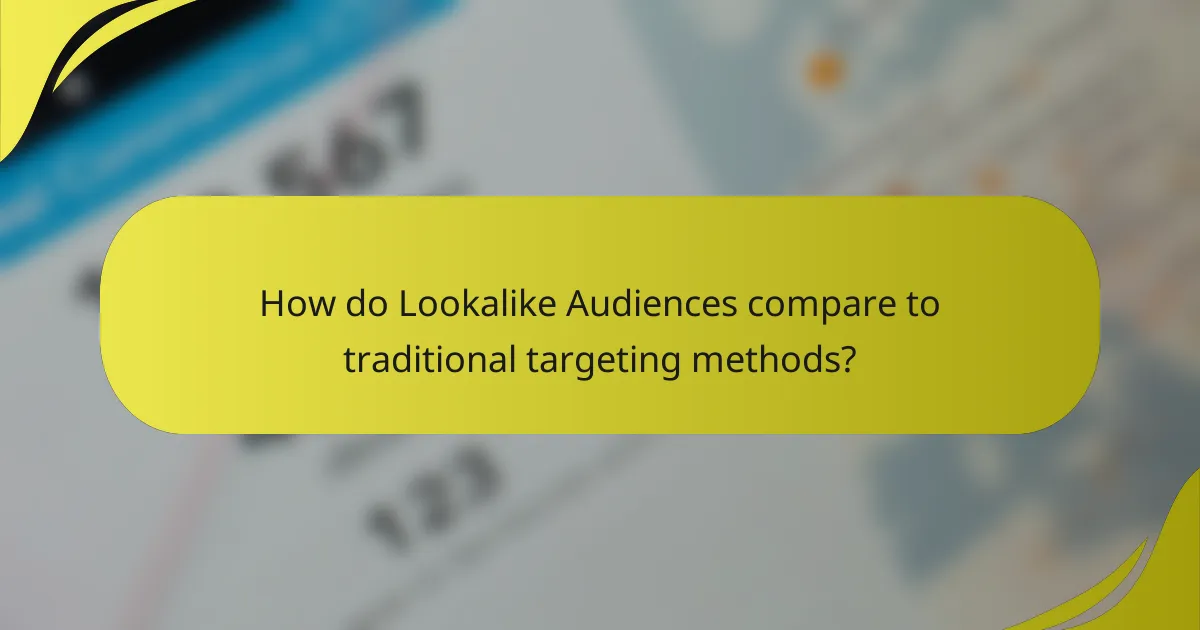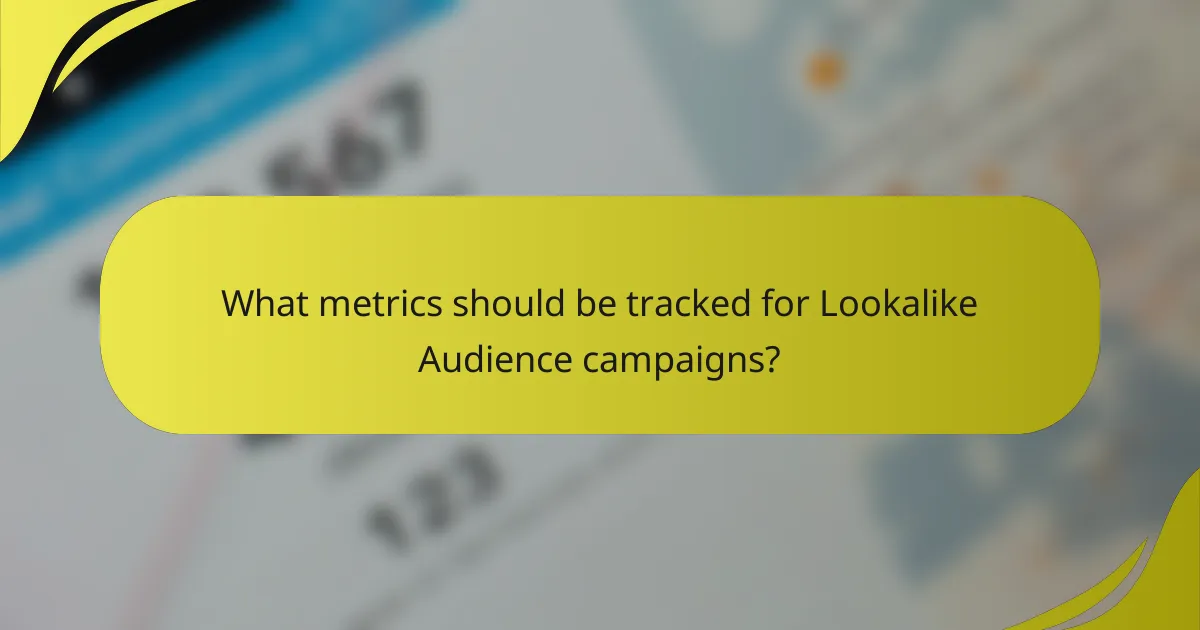Lookalike Audiences enhance display advertising by enabling marketers to target users who closely resemble their existing customers. By leveraging data to expand reach while ensuring precise targeting, this approach significantly improves campaign effectiveness. To maximize results, it is essential to utilize high-quality source audiences and segment based on user behavior.

How do Lookalike Audiences enhance display advertising effectiveness?
Lookalike Audiences significantly boost display advertising effectiveness by allowing marketers to target users who resemble their existing customers. This method leverages data to expand reach while maintaining precision in targeting, ultimately leading to more successful campaigns.
Improved targeting precision
Lookalike Audiences enhance targeting precision by identifying potential customers who share similar characteristics with a brand’s best existing customers. This includes demographics, interests, and online behaviors, enabling advertisers to focus their efforts on users more likely to convert.
To create a Lookalike Audience, businesses typically start with a source audience, such as their current customer list or website visitors. Platforms like Facebook or Google then analyze this data to find new users who match these profiles, ensuring that advertising is directed at the right people.
Increased reach expansion
By utilizing Lookalike Audiences, advertisers can expand their reach beyond their immediate customer base. This strategy allows brands to tap into new markets and demographics that they may not have considered previously, increasing overall visibility.
For example, a company with a strong customer base in urban areas can use Lookalike Audiences to target similar users in suburban or rural regions. This approach not only broadens the audience but also diversifies the potential customer pool, which can lead to increased brand awareness.
Higher conversion rates
Lookalike Audiences often lead to higher conversion rates because they target users who are more likely to engage with the brand. Since these audiences are modeled after existing customers, they tend to have a higher affinity for the products or services offered.
Advertisers should monitor their campaigns closely to assess performance metrics such as click-through rates and conversion rates. A/B testing different Lookalike Audiences can also help identify which segments yield the best results, allowing for continuous optimization of advertising strategies.

What are the best practices for creating Lookalike Audiences?
To create effective Lookalike Audiences, focus on using high-quality source audiences, segmenting based on user behavior, and testing different audience sizes. These practices enhance targeting precision and improve campaign effectiveness.
Utilize high-quality source audiences
Start with a strong source audience, such as your best customers or those who have completed valuable actions like purchases or sign-ups. The more relevant and engaged your source audience is, the better the Lookalike Audience will perform.
Consider using audiences that represent diverse demographics and behaviors. This diversity can help the algorithm identify broader patterns, leading to a more effective reach. Regularly update your source audience to reflect your current customer base.
Segment based on user behavior
Segment your source audience based on specific user behaviors, such as purchase frequency, average order value, or engagement level. This allows you to create more tailored Lookalike Audiences that align closely with your marketing goals.
For instance, if you have a segment of high-value customers, consider creating a Lookalike Audience that mirrors their characteristics. This targeted approach can significantly enhance the relevance of your ads and improve conversion rates.
Test and optimize audience size
Experiment with different audience sizes when creating Lookalike Audiences. Smaller audiences may yield higher precision, while larger audiences can expand your reach. Aim for a balance that aligns with your campaign objectives.
Monitor performance metrics closely to determine the optimal audience size for your specific campaigns. Adjust your audience size based on results, ensuring you maximize both reach and engagement without sacrificing targeting accuracy.

How do Lookalike Audiences compare to traditional targeting methods?
Lookalike Audiences offer a more effective way to reach potential customers compared to traditional targeting methods by identifying users who share similar characteristics with your existing audience. This approach leverages data to expand reach while maintaining targeting precision, leading to improved campaign effectiveness.
Broader audience reach
Lookalike Audiences enable marketers to tap into a larger pool of potential customers by finding individuals who resemble their best existing customers. Traditional targeting often limits reach to predefined demographics, which can miss out on valuable prospects. By utilizing algorithms that analyze user behavior and interests, businesses can extend their reach significantly.
For example, if a company has a solid customer base of tech enthusiasts, a Lookalike Audience can help them find new users who have similar online behaviors, effectively broadening their market without extensive manual research.
Enhanced data-driven targeting
With Lookalike Audiences, targeting becomes more data-driven, allowing for more precise marketing efforts. Traditional methods often rely on broad categories, which can lead to wasted ad spend on uninterested users. In contrast, Lookalike Audiences use sophisticated algorithms to match users based on a variety of factors, such as purchasing behavior and engagement levels.
This means that campaigns can be tailored to reach individuals who are statistically more likely to convert, improving overall return on investment. Marketers can refine their strategies based on real-time data, adjusting their targeting as new insights emerge.
Cost-effectiveness
Utilizing Lookalike Audiences can be more cost-effective compared to traditional targeting methods. By focusing on users who are more likely to engage with your brand, businesses can reduce their cost per acquisition. This approach minimizes wasted ad spend on less relevant audiences, leading to better budget allocation.
For instance, companies may find that their cost per click decreases significantly when targeting Lookalike Audiences, as these users are more inclined to respond positively to the ads. To maximize cost-effectiveness, it’s essential to continually analyze campaign performance and adjust audience parameters as needed.

What platforms support Lookalike Audiences for display advertising?
Several major advertising platforms support Lookalike Audiences, enabling advertisers to reach new customers who resemble their existing audience. These platforms include Facebook Ads, Google Ads, and LinkedIn Ads, each offering unique features and targeting capabilities.
Facebook Ads
Facebook Ads allows advertisers to create Lookalike Audiences based on their custom audiences, such as website visitors or customer lists. This feature helps businesses expand their reach by targeting users who share similar characteristics with their best customers.
To set up a Lookalike Audience on Facebook, you first need to define a source audience, which can be a custom audience of at least 100 people. Facebook then analyzes this data to find users with similar traits, optimizing your ad spend and improving campaign effectiveness.
Google Ads
Google Ads offers Similar Audiences, a feature akin to Lookalike Audiences, which targets users who exhibit behaviors similar to your existing customers. This is particularly useful for display advertising across the Google Display Network.
To utilize Similar Audiences, ensure you have a well-defined remarketing list. Google will then automatically generate a new audience based on the behaviors of users in your list, allowing for more precise targeting and potentially higher conversion rates.
LinkedIn Ads
LinkedIn Ads provides a feature called Matched Audiences, which includes Lookalike Audiences to help you reach professionals similar to your existing contacts. This is especially beneficial for B2B marketers looking to expand their network.
To create a Lookalike Audience on LinkedIn, you need to upload a list of your current customers or leads. LinkedIn will then identify users with similar job titles, industries, and skills, enhancing your targeting precision and campaign effectiveness.

What metrics should be tracked for Lookalike Audience campaigns?
To evaluate the effectiveness of Lookalike Audience campaigns, key metrics include Click-through Rate (CTR), Return on Ad Spend (ROAS), and Cost per Acquisition (CPA). Tracking these metrics helps determine how well your ads are performing and whether your targeting is effective.
Click-through rate (CTR)
Click-through rate (CTR) measures the percentage of users who click on your ad after seeing it. A higher CTR indicates that your ad is resonating with your Lookalike Audience, which can lead to increased engagement and conversions.
To improve CTR, focus on crafting compelling ad copy and visuals that align with the interests of your target audience. Aim for a CTR of at least 1-2% as a general benchmark, but this can vary based on industry and platform.
Return on ad spend (ROAS)
Return on Ad Spend (ROAS) calculates the revenue generated for every dollar spent on advertising. A higher ROAS signifies a more effective campaign, as it indicates that your Lookalike Audience is converting well.
To optimize ROAS, regularly analyze your ad performance and adjust your targeting or creative elements accordingly. A good ROAS target is typically around 4:1, meaning for every $1 spent, you should aim to earn $4 in revenue.
Cost per acquisition (CPA)
Cost per Acquisition (CPA) measures the cost associated with acquiring a new customer through your ad campaigns. Keeping CPA low while maintaining quality conversions is crucial for campaign profitability.
To manage CPA effectively, consider testing different ad formats and targeting strategies. A reasonable CPA varies widely by industry, but aiming for a CPA that is less than your average customer lifetime value is a solid strategy.

